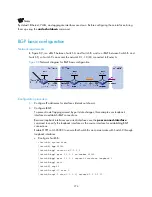
284
0.00% packet loss
round-trip min/avg/max = 2/2/2 ms
BGP load balancing configuration
Network requirements
As shown in Figure 91, all the switches run BGP. Switch A resides in AS 65008, Switch B and
Switch C in AS 65009. Between Switch A and Switch B, Switch A and Switch C are eBGP
connections, and between Switch B and Switch C is an iBGP connection. Two routes are
configured on Switch A for load balancing.
Figure 91
Network diagram for BGP load balancing configuration
Configuration procedure
1.
Configure IP addresses for interfaces (details not shown).
2.
Configure BGP connections.
On Switch A, establish eBGP connections with Switch B and Switch C, respectively;
configure BGP to advertise network 8.1.1.0/24 to Switch B and Switch C, so that Switch B
and Switch C can access the internal network connected to Switch A.
On Switch B, establish an eBGP connection with Switch A and an iBGP connection with
Switch C; configure BGP to advertise network 9.1.1.0/24 to Switch A, so that Switch A can
access the intranet through Switch B; configure a static route to interface loopback 0 on
Switch C (or use a routing protocol like OSPF) to establish the iBGP connection.
On Switch C, establish an eBGP connection with Switch A and an iBGP connection with
Switch B; configure BGP to advertise network 9.1.1.0/24 to Switch A, so that Switch A can
access the intranet through Switch C; configure a static route to interface loopback 0 on
Switch B (or use another protocol like OSPF) to establish the iBGP connection.
a.
Configure Switch A.
<SwitchA> system-view
[SwitchA] bgp 65008
Summary of Contents for S9500E Series
Page 435: ...435 ...
















































